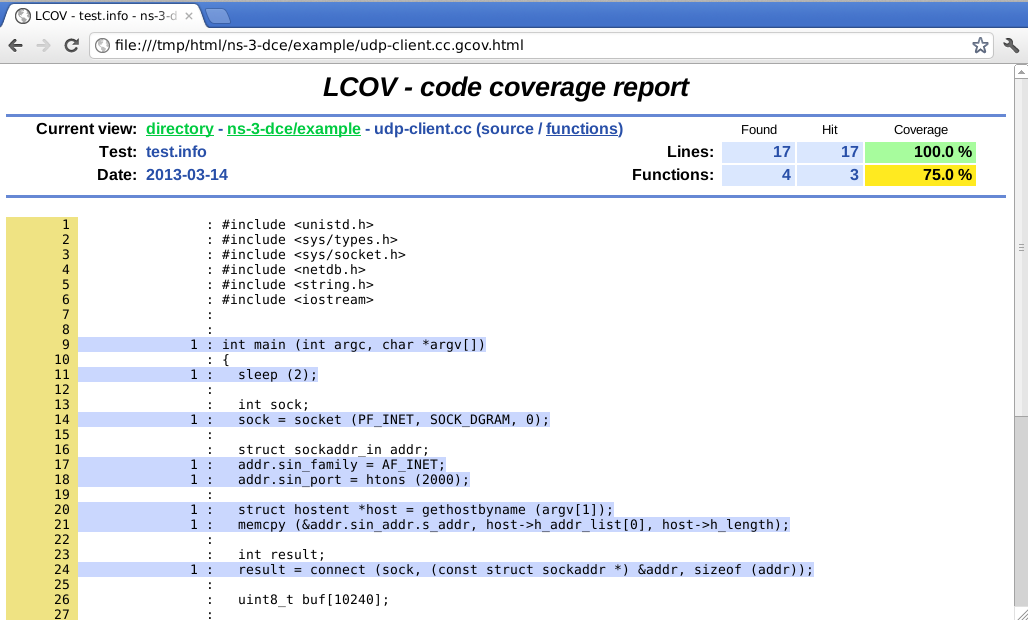Table Of Contents
Previous topic
Debugging your protocols with DCE
Next topic
This Page
Quick search
Enter search terms or a module, class or function name.
Since DCE allows protocol implementations to expose network conditions (packet losses, reordering, and errors) with the interactions among distributed nodes, which is not easily available by traditional user-mode virtualization tools, exercising your code is easily done with a single simulation script.
Improving code coverage with writing test programs is one of headache; - writing test program is annoying, - preparing test network tends to be short-term, and - the result is not reproducible.
This text describes how to measure code coverage of protocol implementations with DCE.
First, you need to compile your application with additional flags. -fprofile-arcs -ftest-coverage is used for a compilation flag (CFLAGS/CXXFLAGS), and -fprofile-arcs is used for a linker flag (LDFLAGS).
gcc -fprofile-arcs -ftest-coverage -fPIC -c foo.c
gcc -fprofile-arcs -pie -rdynamic foo.o -o newapp
Next, write a test program like ns-3 simulation script for your application (i.e., newapp).
$ cat myscripts/dce-newapp.cc
int main (int argc, char *argv[])
{
CommandLine cmd;
cmd.Parse (argc, argv);
NodeContainer nodes;
nodes.Create (2);
InternetStackHelper stack;
stack.Install (nodes);
DceManagerHelper dceManager;
dceManager.Install (nodes);
DceApplicationHelper dce;
ApplicationContainer apps;
// application on node 0
dce.SetBinary ("newapp");
dce.ResetArguments();
apps = dce.Install (nodes.Get (0));
apps.Start (Seconds (4.0));
// application on node 1
dce.SetBinary ("newapp");
dce.ResetArguments();
apps = dce.Install (nodes.Get (1));
apps.Start (Seconds (4.5));
Simulator::Stop (Seconds(100.0));
Simulator::Run ();
Simulator::Destroy ();
return 0;
}
Then, test your application as normal ns-3 (and DCE) simulation execution.
./waf --run dce-newapp
If you successfully finish your test, you will see the coverage data files (i.e., gcov data files) with a file extension .gcda.
$ find ./ -name "*.gcda"
./files-0/home/you/are/here/ns-3-dce/newapp.gcda
./files-1/home/you/are/here/ns-3-dce/newapp.gcda
We use lcov utilities as a parse of coverage test result.
Put the compiler (gcc) generated files (*.gcno) in the result directory,
cp *.gcno ./files-0/home/you/are/here/ns-3-dce/
cp *.gcno ./files-1/home/you/are/here/ns-3-dce/
then run the lcov and genhtml command to generate coverage information of your test program.
lcov -c -d .-b . -o test.info
genhtml test.info -o html
You will see the following output and generated html pages.
Reading data file test.info
Found 8 entries.
Writing .css and .png files.
Generating output.
Processing file ns-3-dce/example/udp-server.cc
genhtml: Use of uninitialized value in subtraction (-) at /usr/bin/genhtml line 4313.
Processing file ns-3-dce/example/udp-client.cc
genhtml: Use of uninitialized value in subtraction (-) at /usr/bin/genhtml line 4313.
Processing file /usr/include/c++/4.4/iostream
Processing file /usr/include/c++/4.4/ostream
Processing file /usr/include/c++/4.4/bits/ios_base.h
Processing file /usr/include/c++/4.4/bits/locale_facets.h
Processing file /usr/include/c++/4.4/bits/char_traits.h
Processing file /usr/include/c++/4.4/bits/basic_ios.h
Writing directory view page.
Overall coverage rate:
lines......: 49.3% (35 of 71 lines)
functions..: 31.6% (6 of 19 functions)

(TBA, about integration of trinity)
(TBA)